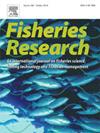湖泊渔业中储存的内陆大西洋鲑鱼和褐鳟鱼的大小和条件指标与再捕获概率的关系
IF 2.3
2区 农林科学
Q2 FISHERIES
引用次数: 0
摘要
放养获得的渔获量可作为鲑科鱼放、养、取(PGT)渔业可行性的指标。在这里,我们报告了一个大型标记项目的结果,该项目将2岁和3岁的内陆大西洋鲑鱼和褐鳟鱼放养在芬兰两个地理位置接近的北方湖泊Pielinen和Höytiäinen中。除了描述这些湖泊渔业的再捕获模式外,我们还评估了通常测量的表型特征(如体长和状况、鳍侵蚀和雄性早熟)是否与再捕获概率有关。在这两个物种和研究湖泊中,释放的鱼在3岁或4岁时被招募到渔场,并暴露于从捕捞曲线估计的高总死亡率(Z = 1.06 - 2.07 yr - 1)。与之前的许多研究一样,在放生时的鱼长与再捕获概率之间发现了正相关关系。在体况的影响下,体长对2龄放养鱼的影响尤为明显。在这两个物种中,早熟和胸鳍侵蚀负相关的鱼的再捕获概率较低。我们的研究结果补充了现有的关于鱼况指标与放养成功之间关系的知识,并为为PGT目的而放生的鱼提供了质量指标。重新捕捞模式强调了渔业管理在减少放养鱼类过早捕捞以确保放养计划的正净产量和降低总死亡率以实现养护目标方面的作用和责任。本文章由计算机程序翻译,如有差异,请以英文原文为准。
Relationship between size and condition metrics and the recapture probability of stocked landlocked Atlantic salmon and brown trout in lake fisheries
Stocking-derived catches serve as indicators of the feasibility of put-grow-and-take (PGT) fisheries for salmonids. Here, we report results from a large tagging program of landlocked Atlantic salmon and brown trout stocked at ages 2 and 3 in two large geographically close boreal lakes, Pielinen and Höytiäinen, in Finland. In addition to describing recapture patterns in these lake fisheries, we assessed whether the commonly measured phenotypic characters such as body length and condition, fin erosions, and early male maturity, were related to recapture probabilities. In both species and study lakes, the released fish recruited to fisheries at 3 or 4 years of age and were exposed to heavy total mortality rate (Z = 1.06 – 2.07 yr−1) as estimated from catch curves. As in many previous studies, a positive relationship was found between fish length at release and recapture probability. Together with the influence of body condition, the effect of body length was particularly strong among fish stocked at age 2. In both species, recapture probability was lower for fish that showed precocious maturity and negatively associated with pectoral fin erosion. Our results complement existing knowledge on the relationship between fish condition indicators and stocking success, and provide data to set quality metrics for fish released for PGT purposes. The recapture patterns underline the role and responsibility of fisheries management in reducing the premature harvest of stocked fish to ensure positive net yields from the stocking programs and decreasing the overall mortality rate to reach conservation goals.
求助全文
通过发布文献求助,成功后即可免费获取论文全文。
去求助
来源期刊

Fisheries Research
农林科学-渔业
CiteScore
4.50
自引率
16.70%
发文量
294
审稿时长
15 weeks
期刊介绍:
This journal provides an international forum for the publication of papers in the areas of fisheries science, fishing technology, fisheries management and relevant socio-economics. The scope covers fisheries in salt, brackish and freshwater systems, and all aspects of associated ecology, environmental aspects of fisheries, and economics. Both theoretical and practical papers are acceptable, including laboratory and field experimental studies relevant to fisheries. Papers on the conservation of exploitable living resources are welcome. Review and Viewpoint articles are also published. As the specified areas inevitably impinge on and interrelate with each other, the approach of the journal is multidisciplinary, and authors are encouraged to emphasise the relevance of their own work to that of other disciplines. The journal is intended for fisheries scientists, biological oceanographers, gear technologists, economists, managers, administrators, policy makers and legislators.
 求助内容:
求助内容: 应助结果提醒方式:
应助结果提醒方式:


